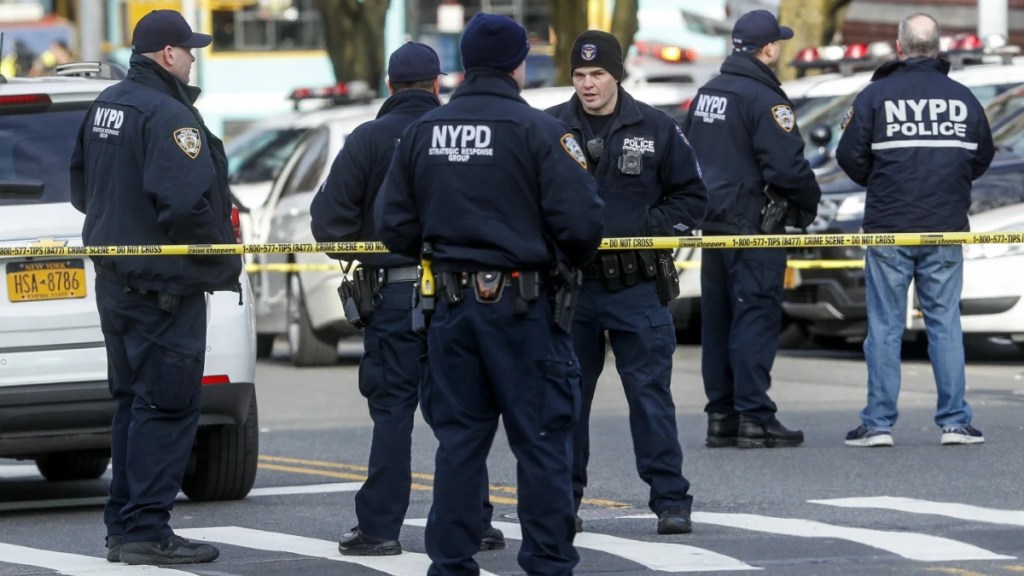Manhattan mass shooting: What began as an ordinary Monday evening rush hour in Midtown Manhattan on July 28, quickly spiralled into chaos and tragedy. A lone gunman, later identified as 27-year-old Shane Devon Tamura of Las Vegas, walked calmly into the lobby of 345 Park Avenue, fatally shot a police officer, and opened fire on civilians. He then vanished into the labyrinth of elevators and hallways inside the 44-storey office tower.
Within minutes, Tamura had killed four people, injured another, and eventually turned the weapon on himself on the building’s 33rd floor. Authorities confirmed it was the deadliest mass shooting in New York City in more than two decades.
Calls and rapid response
As the first shots rang out, terrified employees inside the skyscraper made frantic calls to 911. According to CNN, the NYPD’s electronic log captured the unfolding panic: entries included “SHOTS FIRED/ACTIVE SHOOTER,” “LOCKED SELF IN ROOM,” and “7–8 SHOTS HEARD.” Another caller noted the location as “NFL HEADQUARTERS.”
One woman reported that her husband had called her to say he was hiding in a locked room. Officers from local precincts, Emergency Service Units, and long-weapon squads immediately raced to the scene. The NYPD’s Emergency Service Unit, functioning as a SWAT team, accessed the building’s surveillance centre, obtained a screenshot of the gunman from CCTV footage, and using technology introduced by Commissioner Jessica Tisch, distributed Tamura’s image to officers’ department-issued phones within minutes.
What happened after Tamura entered 345 Park Avenue?
Fresh details reveal that Tamura, wearing body armour and carrying a high-powered M4 semi-automatic rifle, entered 345 Park Avenue just before 6:30 p.m. Surveillance confirmed that he had double-parked his black BMW outside the building at 6:26 p.m.
Moments later, he shot NYPD officer Didarul Islam, a father of two. He then fatally shot Craig Clementi, an NFL employee, and Wesley LePatner, a senior executive at Blackstone. Aland Etienne, a building security guard, was wounded but survived.
Tamura appeared to be heading for the NFL offices but mistakenly took the wrong elevator, ending up on the 33rd floor, which houses Rudin Management. When locked doors blocked his way, he fired through the glass and entered the floor.
Tramura was identified after police teams found his body on the building’s 33rd floor.
What happened on the 33rd floor?
Inside the Rudin offices, Tamura encountered cleaner Sebije Nelovic, who managed to flee and lock herself in a closet. Staff barricaded themselves in conference rooms and used specialised safe bathrooms designed for active shooter situations equipped with Kevlar walls, bullet-proof doors, surveillance monitors, and landline telephones.
However, 27-year-old Julia Hyman, a Rudin employee working late, stepped out of a safe room unaware of Tamura’s presence. He shot her in the back. She staggered to her desk but succumbed to her injuries moments later.
Realising that police were closing in and his path to more victims was blocked, Tamura fired a single shot into his own chest, killing himself.
Tamura’s drive from Las Vegas to New York City
In the days leading up to the deadly Manhattan shooting, Tamura’s movements were tracked across multiple states. On Saturday, July 26, a license plate reader in Loma, Colorado, captured his black BMW with Nevada plates at 1:06 p.m. By Sunday, Tamura had failed to report for his security job at the Horseshoe Casino in Las Vegas, an absence that raised no immediate alarms but marked the start of his cross-country journey. His vehicle was next picked up by a Nebraska State Patrol reader, travelling eastbound on Interstate 80.
Soon after, another reader near Wolcott, Indiana, registered the same car. The final sighting came on Monday at 4:24 p.m., when New Jersey State Police cameras captured his BMW in Columbia, just hours before the shooting. These digital footprints, compiled by law enforcement, paint a chilling timeline of Tamura’s deliberate travel towards New York, where he would carry out the city’s deadliest mass shooting in over two decades.
Law enforcement used license plate readers to trace Tamura’s route from Las Vegas. His black BMW was spotted in Colorado, Nebraska, Indiana, and New Jersey before arriving in New York City. He had failed to report for work at the Horseshoe Casino in Las Vegas the previous day.
Surveillance footage, a disjointed suicide note, and gun receipts began forming a clearer picture of Tamura’s premeditated actions.
What do we know about Tamura’s gun?
Inside the vehicle, police recovered hundreds of rounds of ammunition, including over 800 rounds for a Colt Python .357 Magnum, which was also fully loaded. Tamura had fired a total of 47 rounds during the rampage, according to NYPD and ABC News.
Agents from the Bureau of Alcohol, Tobacco, Firearms and Explosives traced the M4 rifle to a Las Vegas man identified only as “Rick”, a coworker of Tamura’s who had also sold him the BMW.
A licensed gun dealer recalled Tamura purchasing a modified trigger and expressing plans to buy 500 rounds of .223 ammunition.
Back in Manhattan, NYPD crime scene investigators recovered shell casings, bullet fragments, and other forensic evidence from both the lobby and the 33rd floor.
While the motive remains unclear, police are continuing their investigation, examining Tamura’s background, travel history, and psychological state.

